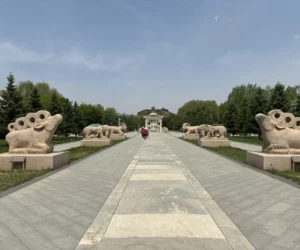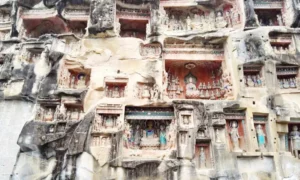Historical Significance of Xiangtangshan Caves Artisans first carved the Xiangtangshan Caves during the Northern Qi Dynasty, between AD 550 and 577. Subsequently, artists from the Sui, Tang, Song, and Ming dynasties also contributed to the caves’ development. These caves, located in Hebei province, stand out as the largest in the region. Craftsmen chose the top-quality…
Sui Dynasty
The Sui Dynasty, a pivotal era in Chinese history, spanned a relatively brief period from 581 AD to 618 AD. It marked a significant phase of reunification and transformation following the fragmentation of the Northern and Southern dynasties period. The foundation of the Sui Dynasty was laid by Emperor Wen, who, through a combination of military conquest and political marriage, managed to consolidate power and unify the country. This era is often credited with laying the groundwork for the subsequent Tang Dynasty, one of China’s golden ages.
One of the major moments of the Sui Dynasty was the construction of the Grand Canal, one of the most ambitious infrastructure projects of ancient China. This grand canal connected the Yellow River in the north to the Yangtze River in the south, facilitating the movement of grain, troops, and communication across the vast empire. This monumental project not only boosted the economy but also unified the diverse regions of China, promoting cultural exchange and integration.
Religion during the Sui Dynasty saw a continuation of the trend of embracing Buddhism, which had been growing in popularity across China since the period of division. Emperor Wen and his successor, Emperor Yang, both were patrons of Buddhism, sponsoring the construction of temples and the translation of Buddhist texts. Buddhism played a crucial role in the social and cultural life of the Sui Dynasty, influencing art, literature, and philosophy.
The social and daily life in the Sui Dynasty was characterized by significant changes, particularly in the agrarian and bureaucratic systems. The implementation of the Equal-field System ensured a more equitable distribution of land, aiming to reduce the gap between the rich and the poor. Additionally, the imperial examination system was introduced, opening up government positions to those who were skilled and knowledgeable, rather than just to those of noble birth. This period saw a move towards a more meritocratic society.
Emperor Wen, also known as Yang Jian, was the founding emperor of the Sui Dynasty. His reign was marked by efforts to consolidate imperial power, improve administrative efficiency, and promote economic prosperity. Following his death, his son, Emperor Yang, took the throne. Emperor Yang’s reign is often remembered for his ambitious projects, such as the Grand Canal and the reconstruction of the Great Wall, but also for his tyrannical rule and extravagant spending, which ultimately led to widespread discontent and rebellion.
The Sui Dynasty, despite its achievements, was plagued by military overreach and internal strife. Emperor Yang’s costly military campaigns, particularly the attempts to conquer the Korean peninsula, drained the state’s resources and weakened the empire’s military strength. These campaigns, coupled with heavy taxation and forced labor for grandiose construction projects, led to widespread peasant uprisings.
The fall of the Sui Dynasty came in 618 AD, when a combination of internal rebellions and external pressures culminated in the assassination of Emperor Yang. The empire’s disintegration paved the way for Li Yuan, a rebel leader and the founder of the Tang Dynasty, to seize power. The Tang Dynasty would go on to inherit and build upon the Sui Dynasty’s achievements, ushering in a period of cultural flourishing and territorial expansion.
The Sui Dynasty, originating from northern China, was instrumental in reuniting a fragmented nation and setting the stage for the prosperity of the Tang Dynasty. Despite its short duration, the dynasty’s impact on China’s political, social, and cultural landscape was profound, laying the foundations for future developments in Chinese civilization.

Wang Zhaojun Tomb and the Ethnic Unity of China
The Tomb of Wang Zhaojun: A Symbol of Unity and Friendship The Tomb of Wang Zhaojun, also known as Qingzhong, stands prominently in the central area of the Zhaojun Museum. This historical site is located on the expansive Hohhot Plain within the Great Wall region of northern China. The tomb, shaped like an inverted funnel,…

Southern Cliff Buddhist Sculptures (Nankan Grottoes)
The Southern Cliff Buddhist Sculptures, nestled in the serene landscapes of Bazhong, Sichuan, China, stand as a monumental testament to the rich tapestry of religious art and cultural exchange that flourished in ancient China. Known also as the Nankan Grottoes, this site harbors a collection of 179 carved grottos, housing nearly 2,700 painted Buddhist statues. Situated merely 1 km south of Bazhong city proper, these sculptures form an integral part of the Nankan Mountain Scenic Area, attracting scholars and tourists alike to delve into their historical and spiritual depths.

